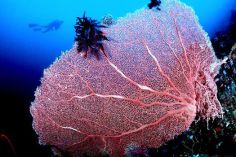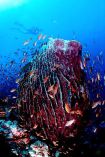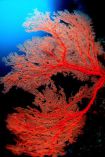Corals
Coral reefs are complex marine ecosystems built by cnidarians known as corals. Although they make up less than 1% of the ocean's surface, they are home to about 25% of all known
marine species. This makes them true hotspots of biodiversity and they are often referred to as the "rainforests of the sea."
The formation of coral reefs is a fascinating and very slow process that can take millions of years. The foundation of these enormous structures are tiny organisms called coral polyps.
The Role of Coral Polyps
Coral reefs are primarily formed by stony corals. These animals have a special ability: They extract calcium carbonate from the seawater and use it to form a hard, calcareous skeleton. Coral polyps
live in colonies, and when a polyp dies, its calcareous skeleton remains. New coral polyps then settle on the old skeletons and build their own calcareous structures.
In this way, the coral colony slowly grows in height and width. Over time, the constant deposition of calcareous skeletons, sand, shells, and other organic materials creates the massive reef
structures we know as coral reefs.
Types of Coral Reefs
Coral reefs are primarily distinguished by their origin and shape. The most common types are:
- Fringing reefs: These reefs grow directly along coastlines and are separated from the shore by a shallow lagoon.
- Barrier reefs: These reefs run parallel to the coast but are located further away and separated by a deep, wider lagoon. The most famous example is the Great Barrier Reef in Australia.
- Atolls: These ring-shaped reefs enclose a central lagoon. They form when a volcanic island surrounded by a reef sinks into the ocean.
- Platform reefs: Small, isolated reefs that grow on the open sea floor and are located between fringing and barrier reefs.
In addition to these tropical reefs, there are also cold-water coral reefs, which occur at great depths and in colder waters, for example, off the coast of Norway.
Importance and Threats
Coral reefs are of great importance not only to marine life, but also to humans. They protect coasts from storm surges and erosion, serve as nurseries for many fish species that feed half a billion
people, and are an important source of active ingredients that could be used in medicine.
Unfortunately, coral reefs are under severe threat from the climate crisis and environmental pollution. Rising water temperatures lead to coral bleaching, a phenomenon in which corals shed their
symbiotic algae, causing them to bleach and die. Plastic waste and pollutants also endanger these fragile ecosystems. Scientists estimate that if current trends continue, up to 99% of all corals
could disappear by the end of the century.
Largest single coral species
- Porites corals (e.g., Porites lutea, Porites lobata) can form massive, dome-shaped structures several meters high and dozens of meters in diameter.
- Some specimens, like "Big Mama" off Samoa, are over 6 meters tall, 17 meters in circumference, and are thought to be over 500 years old.
- Table corals (Acropora) can form individual colonies with diameters of over 6–8 meters, often shaped like gigantic "mushrooms."
Reference: https://de.wikipedia.org/wiki/Koralle
Source Pics: M. Geissler / PG / PH



